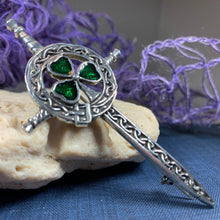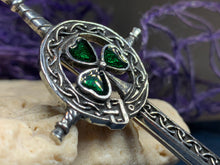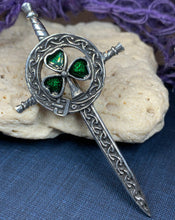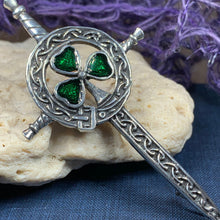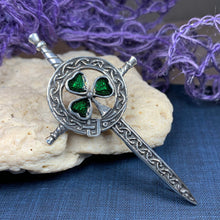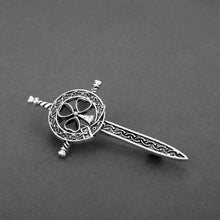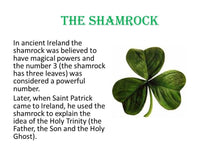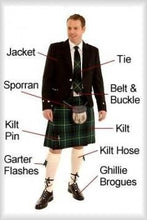
Description
TAKE AN ADDITIONAL 20% OFF THE ALREADY REDUCED SALE PRICE - ADDITIONAL 20% IS DEDUCTED AT CHECKOUT with code SAVE20
A truly beautiful kilt pin with an enamel shamrock - this sword features beautiful Celtic knot work detailing on the the hilt of the sword, all in antiqued pewter.
3" x 1 1/4" with a 2 1/4" locking steel pin
Kilt pins are NOT just for kilts! This pin is made with an extra strong pin to handle thicker fabrics - making it the perfect pin for coats, jackets, skirts, hats or anywhere else a pin would look beautiful. It is a great pin for a ladies cape or ruana wrap!
How and why do I wear a kilt pin?
Ever since Queen Victoria reputedly used her hat pin to secure her kilted skirt modestly on a blustery day, a kilt pin has been worn with a traditional kilt. Its style is entirely a matter of your personal choice. It should be on the right hand side of the kilt, pinned through the front apron only (to prevent tearing) about 4 inches from the bottom of the kilt and 2 inches in from the fringe.
So how did the shamrock become an emblem of Ireland?
It wasn't until the 17th century that it became the custom to wear the shamrock on the feast of Ireland's patron saint; until then, the Irish wore a special St. Patrick's cross, made just for the occasion. Then, in the late 18th century, the shamrock was adopted as an emblem by the Volunteers of 1777. But it didn't really become widely popular until the 19th century, when the emerging Nationalist movements took the shamrock, along with the harp, as one of their emblems.
Viewed as an act of rebellion in Victorian England, Irish regiments were forbidden to display it. This one single act may have done more to establish the shamrock as Ireland's national emblem than anything else.
Today, the shamrock is firmly established as the most instantly recognizable emblem of Ireland. For good luck, it's usually included in the bouquet of an Irish bride, and also in the boutonniere of the groom. And, it's also an integral part of an old tradition called "drowning the shamrock."
This takes place on St. Patrick's Day, when the shamrock that has been worn in the hat or lapel is removed and put into the last drink of the evening. A toast is proposed and then, when the toast has been honored, the shamrock is taken from the bottom of the glass and thrown over the left shoulder. Sláinte!










